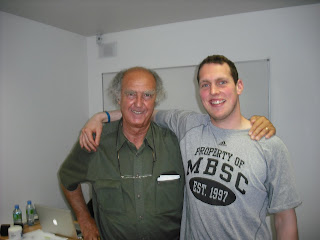
19 year old Gaelic Football Player.
Grade 1 hamstring strain picked up in a 1st round senior football championship game.
Athlete had 6 days to be ready for 2nd game.
SFMA -
C F - DN
C Ex - FN
C Ro/F - Right DN, Left DN
MSF - DP
MSE - DN
MSR - FN
SLS - FN
OH - DN
Rehab Protocol
Day 1 - Saturday Afternoon:
Table Treatment:
Stripped Hamstrings
Performed Soft Tissue Release to Hamstrings and Hip Flexors
MET Hamstrings and Hip Flexors
SFMA Corrective Circuit x3:
Mobility: AIS Hamstring x8
Static Stability: Supported Leg Lowering x8
Dynamic Stability: 1 Leg Glute Bridge (Belly breathing emphasis) x5
Dynamic Stability/Pattern: Reaching Single Leg Deadlift x8
Athlete regained MSF (with a slight stiffness still in hamstring), and MSE.
Day 2 - Sunday Evening:
Athlete spent all Saturday evening at home doing SFMA corrective circuit and iced hamstring, and now had a pain free FN MSF pattern, as well as a FN MSE.
Table Treatment:
Same as Day 1
SFMA Corrective Circuit x3:
Same as Day 1
Pitch Work:
Warm Up:
Perform a 10-15 yard stride after every movement, slowly increasing speed of each stride
Knee Hug
Heel to Butt
Overhead Reach Lunge
Spiderman
Inchworm
Backward SLDL Walk
Straight Leg Walk
A-Skip
High Knees
High Heels
Backpedal
Backward Run
Side Skip
Crossover Skip
Crossunder Skip
Carioca
Side Shuffle
2x6 10yard jog into 20yard strides @50%
2x6 10yards straight leg skip into 20yards of strides @50%
Athlete maintained MSF, which indicated that the hamstring had tolerated the workload placed upon it.
Day 3 - Monday Morning:
Athletes FN MSF remained as did MSE. No Pain at all in hamstring.
Table Treatment:
Same as Day 1&2
SFMA Corrective Circuit x3:
Same as Day 1&2
Pitch Work:
After Warm Up
Circuit x2:
Lunge Matrix x5 Each Leg
Linear Bounds x5 Each Leg
Lateral Bounds x5 Each Leg
Linear Hops x5 Each Leg
Medial/Lateral Hops x3 Each Way
2x6 10yard jog into 20yard strides @75%
2x6 10yards straight leg skip into 20yards of strides @75%
Athlete maintained MSF, which indicated that the hamstring had tolerated the workload placed upon it.
His speed of strides also increased from 50-75%. He reported that when taking off he could feel the hamstring a little bit in the first two strides.
Athlete was advised to rest until following evening. Drink plenty water, eat fish, and clean food, and sleep well to all help promote recovery.
Day 4 - Tuesday Evening
Athletes FN MSF remained as did MSE. No Pain at all in hamstring.
Athlete did report a bit of soreness in Glutes from the previous days pitch circuit. A good thing.
Table Treatment:
Same as Day 1,2&3
SFMA Corrective Circuit x3:
Same as Day 1,2&3 - A more focused soft tissue release to area where stiffness in hamstring had been indicated the previous day.
Pitch Work:
After Warm Up
Circuit x2:
Lunge Matrix x5 Each Leg
Linear Bounds x5 Each Leg
Lateral Bounds x5 Each Leg
Linear Hops x5 Each Leg
Medial/Lateral Hops x3 Each Way
2x6 10yard A-Skip into 20yard strides @75%
2x6 10yards straight leg skip into 20yards of strides @75%
2x6 10 yard Linear Accelerations into deceleration @90-95%
2x3 10 yard Linear Acceleration into 5 yard Side Shuffle @ 90-95%
Athlete maintain MSF, which indicated that the hamstring had tolerated the workload placed upon it.
No pain in hamstring during any of the above activities.
Day 5 - Wednesday Evening
Athletes FN MSF remained as did MSE. No Pain at all in hamstring.
Table Treatment:
Same as Day 1,2,3&4
SFMA Corrective Circuit x3:
Same as Day 1,2,3&4
Pitch Work:
After Warm Up
Circuit x2:
Lunge Matrix x5 Each Leg
Linear Bounds x5 Each Leg
Lateral Bounds x5 Each Leg
Linear Hops x5 Each Leg
Medial/Lateral Hops x3 Each Way
2x6 10yard A-Skip into 20yard strides @ 75-85%
2x6 10yards straight leg skip into 20yards of strides @ 75-85%
2x6 10 yard Linear Accelerations into deceleration @100%
2x3 10 yard Linear Acceleration into 5 yard Side Shuffle @100%
Athlete maintain MSF, which indicated that the hamstring had tolerated the workload placed upon it.
No pain in hamstring during any of the above activities.
Day 6 - Thursday Evening Game Day
Athlete had Kinesio tape applied to hamstring before game. Athlete reported to be feelng great.
First Half - Athlete moved extremely well scoring three points (2 from play, 1 free)
Second half - Athlete felt hamstring and had to come off - Crap!!
Athlete reported afterwards that he felt great in first half, and felt that the half interval (where he sat down for 15minutes, and let the hamstring "get cold"), was the undoing of all the work.
So that was a great lesson. Athlete felt if he had done a mini warm up again (to get heat and blood back into hamstring) at half time, he would have been fine.
Thanks for Reading
Stay Strong,
RB



